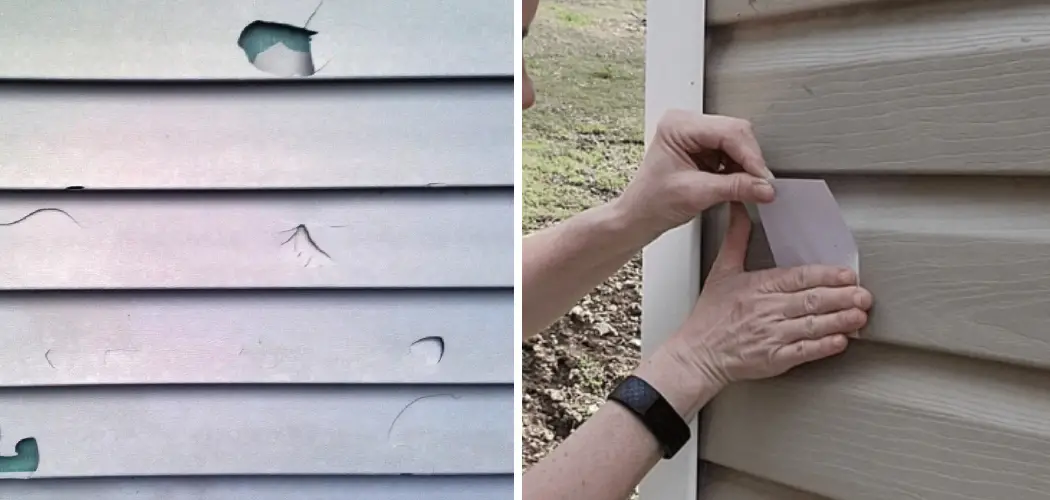Are you dealing with worn-out siding that’s full of unsightly holes and cracks? Does it make your home look tired and uninviting? Don’t worry, you can easily repair those holes without needing to replace the entire siding. With a few simple tools – like sealant, caulk, and putty knives – you can make your home look brand new in no time!
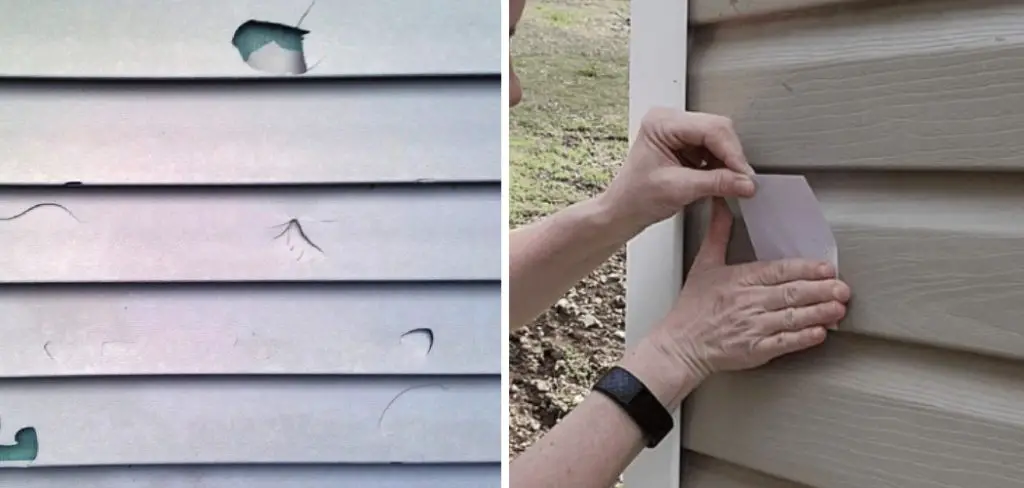
In this blog post, we’ll show you how to fill holes in siding so that your exterior looks as good as new. Read on for our expert tips to ensure perfect results.
Supplies You Will Need to Fill Holes in Siding
- Sealant
- Putty Knife
- Caulk
- Paintbrush
- Exterior paint (if needed)
- Sandpaper
- Cleaning supplies (soap, water, and a sponge)
- Ladder (if needed)
Step-by-step Guidelines on How to Fill Holes in Siding
Step 1: Clean the Surface
The first step to filling holes in the siding is to clean the surface where you’ll be working. Use soap, water, and a sponge to remove any dirt, grime, or mildew buildup around the hole. This will ensure that your repairs adhere properly and give you a smooth finish. Cleaning also helps prevent any further damage to your siding.
Step 2: Prepare the Sealant
Once you have a clean surface, you can prepare your sealant. Use a putty knife to scoop out some sealant onto a tray or paper plate. You can use either silicone or latex-based caulk, depending on the type of siding you have and the size of the hole. Preparing the sealant before you start working will save time and help you achieve a consistent mixture.
Step 3: Apply Sealant to the Hole
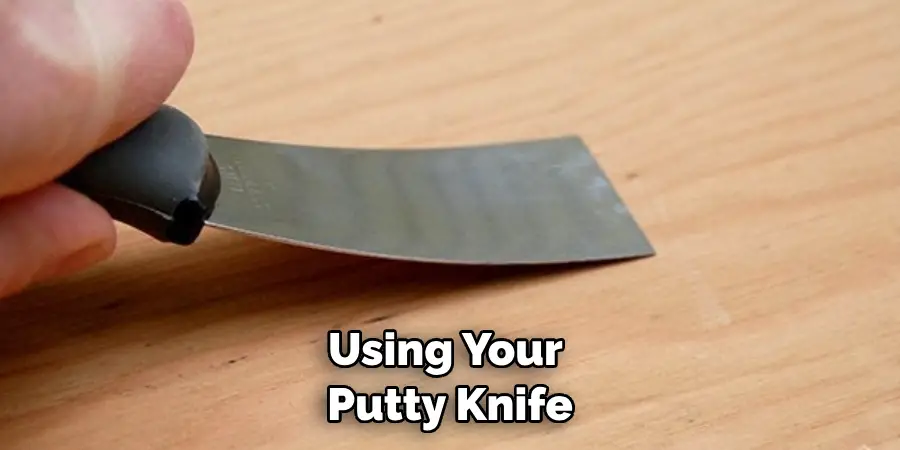
Using your putty knife, apply the sealant onto the hole, making sure it’s completely filled. If the hole is too large or deep, you may need to apply multiple layers of sealant. Make sure each layer is completely dry before applying the next one. Once you have filled the hole, use your putty knife to smooth out the surface and create an even finish.
Step 4: Let it Dry
After filling the hole with sealant, allow it to dry completely. The time needed for drying will depend on the type of sealant you used – check the manufacturer’s instructions for an accurate time frame. Once the sealant is completely dry, use sandpaper to gently sand down any rough spots on the surface.
Step 5: Paint (if needed)
If your siding is painted and you want to maintain a uniform appearance, you can paint over the patched area with exterior paint that matches your existing color. Use a small paintbrush to carefully apply the paint, blending it in with the surrounding area. Allow it to dry completely before touching or applying a second coat if needed.
Step 6: Maintenance
After filling the holes and painting (if needed), you should perform regular maintenance to ensure your repairs hold up over time. Check for any signs of new damage or wear and tear, especially after extreme weather conditions. Make sure to keep the surface clean and make necessary repairs as soon as possible to avoid any further damage.
Following these simple steps will help you fill holes in your siding quickly and easily. As always, it’s important to take proper safety precautions when working on a ladder or handling tools. If the damage to your siding is extensive or requires professional expertise, be sure to consult a contractor for their advice and assistance.
With these tips, you can give your home’s exterior the attention it deserves and keep it looking beautiful for years to come. So, roll up your sleeves and get started on repairing those holes in your siding today! Happy DIY-ing!
Additional Tips and Tricks to Fill Hole in Siding
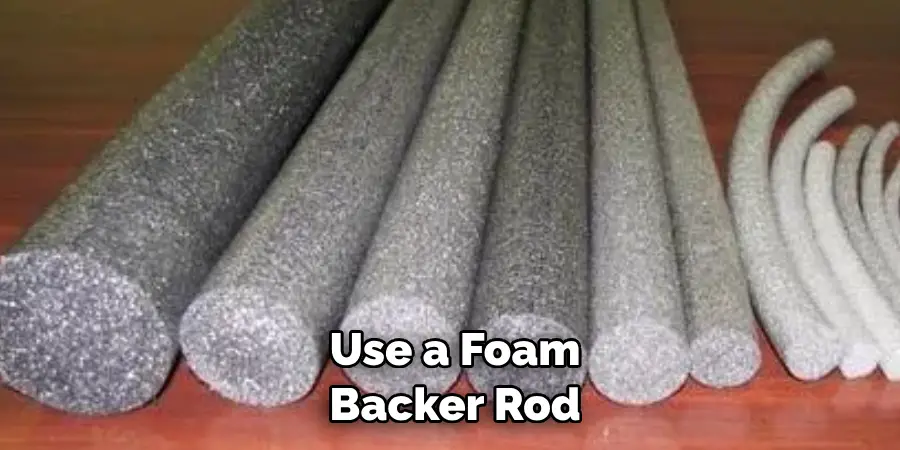
- When choosing a sealant, make sure to use one that is specifically designed for outdoor use and is flexible enough to expand and contract with changing temperatures.
- Before filling the hole, make sure to clean the area thoroughly using a scrub brush and a mild detergent. This will ensure that the sealant adheres properly.
- For larger holes, it may be necessary to use a piece of mesh or wire as a reinforcement before applying the sealant. This will help prevent the sealant from cracking or breaking.
- If you are filling holes in vinyl siding, be sure to use a sealant that is safe for use on vinyl. Some sealants may cause damage or discoloration to the siding.
- To achieve a smooth finish, it’s important to apply the sealant in thin layers and then smooth it out using a putty knife or your finger before it dries.
- If you are filling holes in wood siding, it’s best to use a wood putty or filler instead of a sealant. This will provide a more durable and long-lasting solution.
- For holes that are larger than 1/4 inch in diameter, it may be necessary to use a foam backer rod before applying the sealant. This will help fill the gap and prevent the sealant from sinking into the hole.
- If you are filling holes in brick or stone siding, it’s important to use a sealant that is specifically designed for these materials. These types of sealants will adhere better and provide a stronger bond.
- After filling the hole, be sure to smooth out any excess sealant and clean up any mess using a damp cloth before it dries.
- If the hole is located in an area that is prone to water exposure, it may be a good idea to add a layer of waterproofing on top of the sealant for added protection. This will help prevent future damage or deterioration.
Following these tips and tricks will ensure that you effectively fill any holes in your siding and maintain the integrity of your home’s exterior. Remember to always follow the manufacturer’s instructions when using sealants and be sure to wear appropriate safety gear, such as gloves and goggles, when handling these products. With proper technique and maintenance, your siding will remain strong and beautiful for years to come. So don’t let holes in your siding be a cause for concern, use these tips to fix them with confidence. Happy home repair!
Precautions Need to Follow for Filling Holes in Siding

- Wear gloves and protective eyewear before starting the task to prevent any injuries.
- Clean the area around the hole with a clean cloth or brush to remove any debris or dirt that may interfere with the patching material.
- Ensure that you have the necessary tools and materials for filling holes in the siding, such as caulk, putty knife, sandpaper, and paint matching the color of your siding.
- Follow the instructions provided by the manufacturer for any specific products you are using, as they may have different application methods.
- Test the patching material on a small inconspicuous area first to ensure it matches the color and texture of your siding before applying it to the hole.
- Work in a well-ventilated area to avoid inhaling any fumes from the patching material.
- Use a ladder or scaffolding for reaching higher areas of your siding, and make sure it is secure and stable before climbing on it.
- If you are using caulk to fill the hole, keep in mind that it may shrink as it dries, so you may need to apply multiple layers to completely fill the hole.
Following these precautions can help ensure a safe and successful hole-filling experience. It is also important to note that if you are not comfortable or confident in your ability to fill holes in siding, it may be best to hire a professional for the job. They have the necessary expertise and tools to do the job effectively and safely.
Frequently Asked Questions
What is the Best Way to Fill Holes in the Siding?
Filling holes in siding is an important maintenance task to keep your house looking great and prevent moisture from seeping inside. There are several methods you can use to fill holes in siding, but the best method will depend on the type of siding you have and the size and location of the hole.
How Do I Know Which Method to Use?
The first step is to identify the type of siding you have. Some common types include vinyl, wood, fiber cement, and aluminum. Each of these materials has its own specific strengths and weaknesses, so it’s important to choose the right method for your specific type of siding.
Can I Fill Large Holes in the Siding?
Yes, it is possible to fill large holes in siding, but it may require a different approach than smaller holes. For larger holes, you may need to use a combination of patching material and replacement pieces of siding. It’s best to consult a professional if you are unsure how to handle larger holes.
How Can I Prevent Holes in Siding?
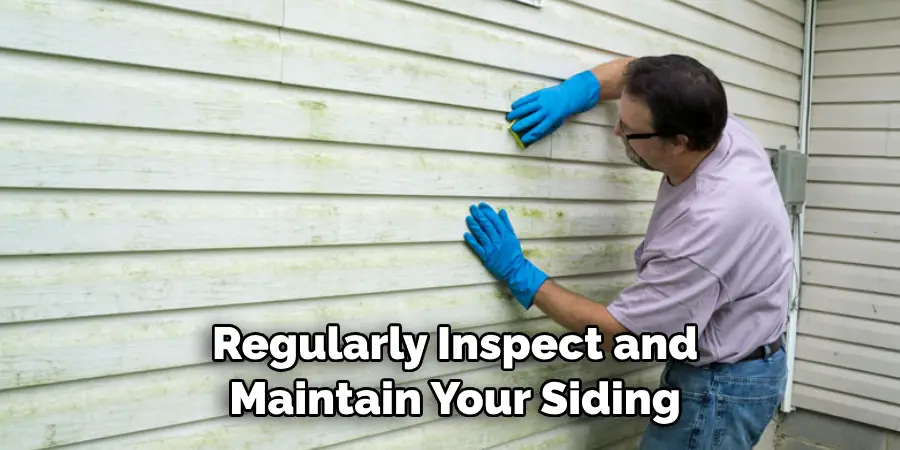
To prevent holes from forming in your siding, it’s important to regularly inspect and maintain your siding. This includes checking for any signs of damage or wear, cleaning the siding, and making repairs as needed. You should also be cautious when using tools or equipment near the siding to avoid accidental damage.
Conclusion
All in all, now you know how to fill holes in siding, the best method to use for your specific type of siding, and how to prevent holes from forming in the future. Remember that regular maintenance is key to keeping your siding in good condition and protecting your home from moisture damage.
If you have any concerns or questions about filling holes in your siding, don’t hesitate to consult a professional for advice. So keep an eye on your siding and take action as soon as you notice any holes to keep your home looking great for years to come! So don’t wait, get started on filling those holes today. Happy home maintenance!

